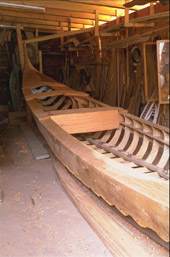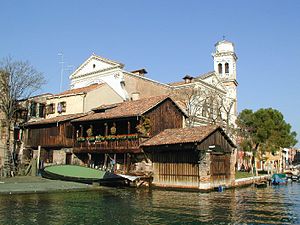Squero: Difference between revisions
Created page with "<br>right|thumb|200px|''Gondola'' construction occurring at a ''squero'' The term '''''squero''''' is the Venetian word for a boatyard. The plural f..." |
No edit summary |
||
| Line 1: | Line 1: | ||
<br>[[File:Gondolasquero.JPG|right|thumb|200px|''Gondola'' construction occurring at a ''squero'']] | <br>[[File:Gondolasquero.JPG|right|thumb|200px|''Gondola'' construction occurring at a ''squero'']] | ||
The term '''''squero''''' is the Venetian word for a boatyard. The plural for this term is '''''squeri'''''. [[Traditional boats]] such as the ''[[sandolo]]'', ''[[mascareta]]'', '' | The term '''''squero''''' is the Venetian word for a boatyard. The plural for this term is '''''squeri'''''. [[Traditional boats]] such as the ''[[sandolo]]'', ''[[mascareta]]'', ''puparin'', and ''[[gondola]]'' are still hand-built in traditional ''squeri''. These traditional ''squeri'' are home to some of the world’s most talented wooden boat craftsmen, the ''[[squerarioli]]''.<ref>"The Gondola, Its History and Usefulness." Sito Ufficiale Della Gondola Veneziana. Web. 12 Oct. 2011. <http://www.gondolavenezia.it/history.asp>.</ref> Most ''squeri'' are small, often dedicated to building only one particular type of boat. | ||
The loading area of a ''squero'' consists of a downward sloping ground that goes directly from the boatyard into the [[canal]]. This allows effortless transport and also eliminates the risk of damaging boats.<ref>Catalano, Brian, Kristen Gervais, and Ryan Sinapius. Preserving the Nautical Traditions and Maritime Heritage of Venice, Italy. Interactive Qualifying Project, Worcester Polytechnic Institute, 2005.</ref> | The loading area of a ''squero'' consists of a downward sloping ground that goes directly from the boatyard into the [[canal]]. This allows effortless transport and also eliminates the risk of damaging boats.<ref>Catalano, Brian, Kristen Gervais, and Ryan Sinapius. Preserving the Nautical Traditions and Maritime Heritage of Venice, Italy. Interactive Qualifying Project, Worcester Polytechnic Institute, 2005.</ref> | ||
The largest and most well-known ''squero'' in Venice is the [[Arsenale]], also known as the "State Squero", founded in 1104 A.D. and still standing today. | The largest and most well-known ''squero'' in Venice is the [[Arsenale]], also known as the "State Squero", founded in 1104 A.D. and still standing today. | ||
Revision as of 20:23, 12 December 2012

The term squero is the Venetian word for a boatyard. The plural for this term is squeri. Traditional boats such as the sandolo, mascareta, puparin, and gondola are still hand-built in traditional squeri. These traditional squeri are home to some of the world’s most talented wooden boat craftsmen, the squerarioli.[1] Most squeri are small, often dedicated to building only one particular type of boat. The loading area of a squero consists of a downward sloping ground that goes directly from the boatyard into the canal. This allows effortless transport and also eliminates the risk of damaging boats.[2] The largest and most well-known squero in Venice is the Arsenale, also known as the "State Squero", founded in 1104 A.D. and still standing today.
Historical Usage
Traditional boats were handcrafted in Venice and each squero specialized in a different type of boat, this was done in order to meet the demands of the Venetian residents. A few characteristics of all traditional boats are common, including flat bottoms and a narrow draft hull. These characteristics are necessary to allow the ships to navigate throughout the shallow waters of the Lagoon. Specific squeri would typically specialize in the manufacture of one type of boat in order to maximize productivity. For example, a squero which created gondole will need to manufacture the boats in such a way to allow the gondolier to paddle on just one side of the boat without causing it to turn.
Squeri Today

There are seven squeri in the Venice lagoon that still build traditional boats. The oldest functioning squero still in existence is the Squero of San Trovaso, which dates back to the year 1612 when it employed approximately 60 boatbuilders. [3]
Table of Existing Squeri
The following is a compilation of the remaining traditional squeri in the Venice and the surrounding lagoon islands. [4]
| Title | District | Open/Closed | Management | Primary Service | Annual Production |
|---|---|---|---|---|---|
| Cantiere Vidal | Burano | Open | Vidal Family | New Boat Construction | 4 New Boats |
| Cantiere Amadi | Burano | Open | Vittorio Amadi | New Boat Construction | 0-1 New Boat(s) |
| Squero Crea | Dorsoduro | Open | Franco Vienello | New Boat Construction | 5-6 New Boats |
| Squero Canaletto | Cannaregio | Open | Thom Price | New Gondola | 1 New Gondola |
| Squero of Giudecca | Dorsoduro | Open | Roberto Dei | New Gondola | 5 New Gondole |
| Squero at Ognissanti | Dorsoduro | Open | Nedis | New Gondola | 2-3 New Gondole |
| Squero of San Trovaso | Dorsoduro | Open | Lorenzo | New Gondola | 1 New Gondola |
| Squero of Strada Guidecca | Dorsoduro | Closed | Unknown | No Operations | N/A |
| Squero on San Pietro | Castello | Closed | Unknown | No Operations | N/A |
| Squero on Mendicanti Canal | Cannaregio | Closed | Circolo Nautico | Rowing Club Boat | N/A |
| Squero on Mendicanti | Cannaregio | Closed | Unknown | Storage Facility | N/A |
| Squero at Anconeta | Cannaregio | Closed | Unknown | Storage Facility | N/A |
| Sqero at Servi | Cannaregio | Closed | Arzana | Boat Preservation | N/A |
| Squero in Corte of Mutti | Cannaregio | Closed | Unknown | Under Construction | N/A |
Squeri Locations
See Also
References
- ↑ "The Gondola, Its History and Usefulness." Sito Ufficiale Della Gondola Veneziana. Web. 12 Oct. 2011. <http://www.gondolavenezia.it/history.asp>.
- ↑ Catalano, Brian, Kristen Gervais, and Ryan Sinapius. Preserving the Nautical Traditions and Maritime Heritage of Venice, Italy. Interactive Qualifying Project, Worcester Polytechnic Institute, 2005.
- ↑ Bigda, Bryan, Michelle Dubuke, Daniel LaTorella, and Jennifer Richards. Museo Arzanà: Preserving the Traditional Boats of Venice. Interactive Qualifying Project, Worcester Polytechnic Institute, 2007.
- ↑ Candlish, Sean, Craig Shevlin, and Sarah Stout. The Traditional Boats of Venice: Assessing a Maritime Heritage. Interactive Qualifying Project, Worcester Polytechnic Institute, 2004.
Bibliography
NULL